

Employee recruiting continues to undergo massive shifts. In 2021, organizations were met with what’s been dubbed as “The Great Resignation.” Employees are resigning in record numbers—more than 4.5 million in November 2021, according to Labor Department stats. According to the Pew Research Center, workers cite that low pay, a lack of opportunities for advancement and feeling disrespected at work are the top reasons why Americans quit their jobs.
However, it’s not just resignations that are causing problems for businesses: Many hiring managers report a fundamental mismatch between candidates who are looking for work and the skills that are needed. What employees are seeking from a work environment also is changing, with many employers caught between whether to emphasize in-office, hybrid or remote work opportunities.
The good news is that organizations that optimize their talent acquisition and retention practices have the best chance of surviving and remaining competitive. In this comprehensive resource, we’ll look at why organizations of all sizes and in all industries are experiencing so many talent acquisition and retention changes—and how those changes should guide your efforts to manage ongoing workforce needs.
When it comes to talent acquisition and hiring, the COVID-19 pandemic was a disrupter, but it merely served as an accelerator to change that was already in the works. Now, companies need to adapt their approach. According to the Harvard Business Review, technological breakthroughs have made some skills obsolete, traditional talent pools may not always yield the best candidates and employers now need to offer candidates an “employment value proposition.”
Let’s dig deeper. Why is change happening, and how should companies respond?
For decades, rapidly advancing technology has impacted business operations, worker skills and expectations. While these advancements have been gradual, the COVID-19 pandemic sent them into overdrive.
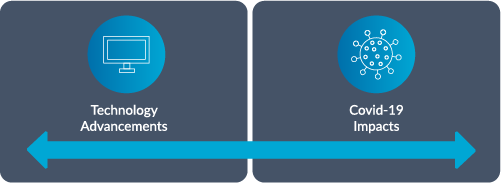
Post-pandemic, employees are more likely to expect flexible hours, remote work options and highly competitive benefits. As a result of changing expectations, employees are leaving jobs at record rates for new horizons—with many employers left empty handed and understaffed.
In fact, in 2021 there were 8.6 million people considered out of work in the U.S. and nearly 10 million job openings, a figure that has only grown. This “resignation revolution,” as it has been deemed, is forcing employers to get creative to fill vacancies; signing bonuses are becoming more commonplace, and some companies have begun to offer pet insurance as part of their compensation packages.
Although ever-emerging technologies and the pandemic certainly aren’t the only factors driving change, much of today’s talent acquisition and retention environment is a reflection of their influence.
Today’s hiring dynamics are multi-faceted; here are three ways that staffing and recruiting are changing before our eyes.
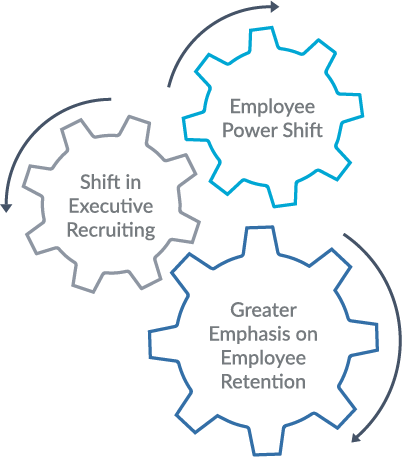
Shifts in market dynamics require companies to revisit assumptions about recruitment solutions. Because companies have more roles to fill than they have options to fill them, workers are leveraging this opportunity to voice new expectations.
Challenges for business leaders include:
Many companies are also seeing new turnover at the C-suite and executive levels. To recruit specialized staffing, organizations are not only charged with vetting candidates for qualifications and expertise, but also looking for individuals who can positively influence company culture, support work efficiency and drive growth.
In the past, workers stayed at companies for decades and had limited interaction with other organizations. Today, seasoned workers have more options than ever. Today’s companies are now forced to concentrate on employee retention as part of a long-term recruitment solution.
A cornerstone of the changing staffing and recruiting dynamics of today’s talent market is the increase in remote work.
Since the pandemic began, more employers are willing to not only hire fully remote workers, but also consider hiring them from locations that aren’t in proximity to their business.
In a post-pandemic culture, 36% of companies shared that they are willing to hire fully remote workers. Before that, a mere 12% of organizations were receptive.
A survey of more than 1,000 hiring managers indicates that 40.7 million Americans expect to be working remotely by 2026, according to a remote work trends report by Upwork Inc.
To address the challenges in today’s staffing and recruiting market, businesses that want to be competitive need a solid strategy. Yet, many mid-size businesses cannot afford to develop a full-scale HR and hiring department. Cutting corners to expedite hires and tapping into shallow hiring pools can turn out to be a costly mistake leading to perpetual turnover.
In 2019, there were about 1 million more job vacancies than active job hunters to fill these openings. In just a short time, talent acquisition became drastically more challenging. The U.S. Bureau of Labor Statistics reports that the number of job openings was at a series high of 11.5 million just three years later.
![]()
Because many companies are currently experiencing higher resignation rates than usual, it may be beneficial for organizations to adopt a talent acquisition approach to fill these roles while still observing the long-term goals of the organization.
Talent acquisition and recruitment are two popular approaches to filling vacant positions within organizations that play a part in a company’s hiring strategy. Let’s examine the definitions of each function to gain a clearer understanding.
Recruitment is the work of searching, evaluating and hiring reliable and qualified individuals to fill positions in your organization. Recruitment follows a reactive, defined process with the singular aim to fill openings at a company.
In contrast, talent acquisition is a proactive approach to understanding the long-term aims of your business. Talent acquisition is a concept that involves a strategy to find future leaders and employees with skills to help your company grow.
Determining the right talent acquisition vs. recruitment approach can become confusing because the two have a similar goal—to get the best person to join and remain with your company.
Knowing the differences in talent acquisition and recruitment can better position companies to create processes and compete in today’s workplace climate.
By knowing the similarities and differences between talent acquisition vs. recruitment, you can create a long-term strategy to anticipate needs and respond to challenges—one that will outlast the challenges of the current job market. Here are three questions to ask when creating a hiring strategy to solve immediate and future needs.

Know your primary aim. With so many openings, some companies need to fill roles to keep business running at its usual pace. On the other hand, other companies are looking to fill strategic or executive leadership positions. In some cases, the needs may encompass both. A word of caution: Even if your company is primarily focused on current vacancies, it’s still important to consider long-term goals
Be very clear—internally and externally—about what hard and soft skills you expect from candidates. This may require time spent on inquiry beyond what fits in a job description to ensure your company is evaluating a candidate sufficiently. Don’t hire based only on what’s been done before, but instead on what will move your company forward.
Often, the applicant who made the best impression during the interview process gets hired. But an interview may demonstrate only a person’s communication skills—not necessarily their technical skills, capabilities or other assets. Consider using a scorecard to better examine quantitative data and remove sentimentality from the equation. That way, you’re more likely to choose employees based on qualifications instead of relying on arbitrary factors such as communication skills.
Understanding talent acquisition vs. recruitment—and leveraging their differences to your advantage—can allow you to plan for future expansion and growth, while also meeting pertinent needs as they arise.
Hiring new employees is expensive and time consuming for any size company. In fact, the onboarding process can cost as much as 33% of the position’s annual projected salary. Now consider what this means for a business with a small HR staff.
The complexities of today’s job market, including dealing with unprecedented resignations on the global scale, make attracting and retaining talented employees one of the most important functions in your organization. But what if the demands have outpaced your HR team’s capacity?
Many small to mid-sized companies may choose to use only in-house HR professionals as their talent acquisition team. Naturally, these individuals understand company culture best, so it’s critical that they’re involved in the talent acquisition process.
Just bear in mind that there is so much more to an organization’s HR needs than talent acquisition alone. Other HR functions may fall to the wayside if your internal HR group is focused mainly on talent acquisition. To protect internal processes while building talent reserves, you can learn how to improve the efforts of your talent acquisition team.
Your company’s needs and goals should dictate who you’ll select for your internal talent acquisition team. Consider including individuals from these groups:
|
|
|
|
|---|---|---|
HR Team:It may go without saying, but don’t underestimate how the HR team’s intimate knowledge of compensation and benefit topics can aid your hiring decisions. |
Leadership:Organizational leaders are key to crafting a long-term talent acquisition strategy because they can weigh in on objectives and vision. |
Trusted Staff:It’s not only leadership who should be driving decisions. Consider involving a trusted staff member to weigh in. They’ll have fresh perspectives and insights. |
An important part of creating a strategy is identifying and documenting your company’s mission, vision and future goals—then translating those into core competencies for new hires. It’s important to continually evaluate the success of your company’s talent acquisition efforts.

When companies find that their internal talent acquisition team is taxed with more than they can handle, many organizations turn to a talent acquisition specialist.
Partnering with a talent acquisition specialist is one way to increase your efforts without hiring more staff. Plus, building your talent acquisition strategy framework with the help of consultants gives your internal team more time to be strategic. In turn, your company’s talent acquisition efforts become more competitive.
![]()
A talent acquisition specialist is a professional whose expertise is in helping organizations establish a proactive, long-term hiring strategy that aligns with a company’s overall future business objectives.
A talent acquisition recruiter works in conjunction with hiring managers, HR professionals and talent sourcing experts to create a dynamic team that serves as an evolving source of information and analysis for feeding your talent pipeline.
While talent acquisition specialists are instrumental in helping businesses find and recruit top-notch candidates over the long term, this is not their only function. These professionals are experts in guiding the hiring process for in-house teams to streamline success.
Let’s look at three examples of how a talent acquisition manager can help your company make progress with recruiting.
1. Develops a Detailed, Long-Term Talent Acquisition StrategyAn advisor can help advance your business by not simply filling empty roles, but also by aligning your hiring strategy with your current situation and future goals. Your talent acquisition manager can employ data, statistics and the previous success of your recruitment process to help you create a comprehensive plan for building your organization’s future through strategic hires. |
|
2. Monitors the Competition for Talent in Your IndustryYour talent acquisition specialist will continually keep tabs on your competition, guiding you on ways to offer better compensation, more recognition and valued feedback. |
|
3. Helps Your Business Become More Agile and FlexibleMarket fluctuations will happen, depending on factors such as internal business circumstances and shifts, external economic or environmental impacts and ongoing supply chain challenges. A talent acquisition manager can help build and flex your hiring muscles as needed to evolve when conditions change.  |
It’s important to note that one of the biggest benefits to working with the right talent acquisition specialist is that they will know your industry far more closely than a generalist. This expertise serves a company in several key ways.
Given the shifting hiring landscape, developing the right compensation package has become more challenging. Access to the right data and experience to understand the current market pulse is imperative when determining competitive market value.
A talent acquisition expert specializing in your industry can analyze your compensation structure in comparison to industry standards and companies similar to yours. This view from the field is incredibly valuable, since it will be most timely and reflect actual dynamics at play. Compensation and benefit offerings vary greatly among positions, companies and industries, so it’s crucial to have access to data and expertise that’s current and relevant.
The best talent acquisition specialists are regularly interacting with top talent in their clients’ specific niches. They know the movers and shakers. The deeper your talent acquisition specialist’s network, the greater access your company will have to the right talent pool.
Also, speed and agility in filling roles comes into play. When you’re looking for talent for a specific role, the chances are strong that your recruitment expert already has several leads on potential candidates because he or she is already deeply entrenched in your industry’s network. Should the nature of the role shift, those in talent acquisition who specialize in the industry will have an easier time pivoting to other desirable candidates quickly.
Perhaps the most important value of a talent acquisition specialist is recognizing changing industry dynamics and being able to use this lens to identify differences among candidates in a way others can’t.
Industry specialists will have a good understanding of all that’s needed to effectively complete tasks in a given role, and they’ll be able to weigh in on trends that may shape the role going forward. This industry context can make it easier to identify candidates and make hiring decisions that will best align with a company’s longer-term goals.
Yes, your industry recruiter will already know which skills your candidates should have, what tools they should know and what software they should understand. But industry insight will also help them recognize the competencies and skills likely to be needed in the future.
Having this total picture can be particularly valuable when looking to fill technical positions that support an organization’s strategic position and competitive readiness, such as roles in engineering and IT.
It’s no surprise that in a highly competitive market, positions that are typically challenging to fill become even more difficult. But there is hope. We’ve isolated some tips that can help you locate the best candidates for three particularly tough fields to staff: engineering, accounting and IT.
Engineering recruitment is one area where a recruiting generalist just won’t cut it. Finding highly skilled engineers has never been easy, and that’s even more true in the competitive market today. And because recruiting for engineers is different from recruiting for non-technical positions, finding the right engineering recruitment firm is paramount.
Rather than plugging “engineering recruiters near me” into a search bar, try qualifying a recruiter using inquiry. It can yield valuable insights into their level of expertise.

Niche training and expertise in engineering matters. Working with an engineering recruitment firm gives you access to recruiters who will have a thorough understanding of how engineering projects work. This insider’s perspective means that they can select candidates for the exact skills needed, while also taking a long view of how a potential hire fits into your larger goals.
Engineering timelines are of the utmost importance. That’s why it’s crucial to assess if engineers have a history of missing deadlines or going over budget when they’re managing big projects. The right engineering recruitment firm will investigate this closely and fully vet a candidate’s history.
Face-to-face conversations are your best advantage. They can reveal much more about a how a candidate will be suited to the massive technological advancements and digital and remote work environment. Experienced engineering recruitment agencies should make in-person meetings a priority when possible.
A generalist may not understand project management, estimating and project controls software. By contrast, engineering recruitment firms can translate how a candidate’s skills will be relevant to work with a particular system.
Ongoing education is essential in the engineering field. Top engineering recruiting firms are constantly networking and gaining insider knowledge. With the evolving nature of STEM fields, a generalist may not be on top of pertinent changes that could affect hiring success.
Building an in-house finance team for small and mid-sized companies is essential to success, and it’s important to get it right. After all, a well-structured and strong finance department is the backbone of every organization.
If you are a newcomer to working with accounting recruiting firms, it can be taxing to determine whether your recruiter is actually a specialist in finding high-caliber accounting candidates. We’ve isolated some of the key questions to ask when partnering with accounting recruiters.
Find out what your accounting recruiters have done with local companies like yours over the past two years. This will give you an objective indicator of their effectiveness. You want a firm that has the expertise to get results for clients, even amid a tumultuous marketplace.
Your accounting recruiters should be transparent about how they source talent. In general, steer clear of a firm that simply combs job boards, LinkedIn and social media posts.
Being involved in industry events means more than holding an association membership. Find out if they are constantly meeting and connecting with accounting professionals, and ask which events they attend.
If your accounting recruiters are not familiar with the substantial differences between general ledger accounting roles and financial analysis roles, then it’s probably wise to keep looking.
Ensure your accounting recruiters know what type of software is needed for specific roles to ensure each candidate has the software skills needed.
For example, Deltek Costpoint ERP has become a crucial software used by government contracting accountants, so it’s key for an accounting recruiter to know how to assess a candidate’s skill level and familiarity with this tool.
It’s also a good idea to check their familiarity with the seasonal nature of the industry and see if they understand the main differences between public accounting versus industry accounting. The takeaway? It’s impossible to ask too many questions when hiring a specialized accounting recruiter.
It would be an understatement to say that IT professionals are in high demand. And you simply have to have specialized help if you expect to attract the brightest stars; however, not all IT recruiting firms are created equal. Asking a few pointed questions can be the difference between hiring a dud and finding excellent IT recruitment companies. Here are the best inquiries to make.
Don’t waste time with a recruiter who doesn’t grasp your company’s SDLC. Check to see if your recruiter understands these specific elements:
Great IT recruiting firms go beyond identifying candidates. They should be able to help you perform a skills gap analysis test to identify the important skills that are currently lacking within your company. IT recruitment agencies also need to be able to reach candidates with highly specialized IT knowledge to align with your particular needs.
Ask IT recruitment companies how they will evaluate candidates’ skills based on your in-house technology stack.
High-quality IT recruiters will keep in touch with outstanding talent and continuously build new contacts through their networks. Recruitment agencies should attend IT events in order to make new connections.
Simply put, IT recruitment agencies should fully grasp the functionality of the technology you use, how it fits into your company, why it’s important to your operations and how certain team members interact with it. Though they may not be an expert in every IT subspecialty, your hire should definitely work in your space.
Even in this challenging labor market, it is possible to find an IT recruitment partner who not only understands your company and the open role at hand, but also the technology environment—and what makes candidates successful in it.

Most companies don’t hire employees with the expectation that they will leave in a year, two or even five. But, the labor market can shift instantly. As early as August of 2020, 18.9 million Americans were willing to change jobs or leave the workforce entirely. By 2021, one in four employees had already resigned. The key to withstanding these changes is to prioritize employee retention.
Employee retention has always been important, but today keeping your star employees can be the difference in keeping your company running smoothly and folding.
Employee retention refers to a business’s ability to keep its best employees on the payroll for a long period of time. Doing so depends on an organization’s efforts to keep employees engaged, satisfied and committed.
![]()
Employee retention is a business’s ability to keep valued and valuable employees on the payroll for the long term
The key to retention management is to consistently follow best practices. Those who do can expect to see a myriad of benefits. Organizations with superior employee retention programs will realize the following advantages:
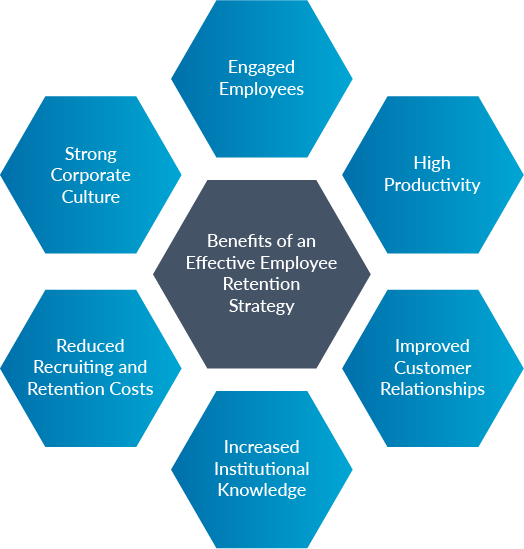
Did you know that resignations can cost a business approximately 33 percent of an employee’s annual salary? When you do the math, you’ll see that this figure includes more than what you’ll spend to train a replacement—including HR responses, lower morale and time invested in rehiring. Retaining team members, in turn, cuts costs and preserves resources.
Positive employee morale is a benefit of employee retention that leads to many additional benefits for companies. Today’s employees need to feel valued beyond salary and benefits. This gives employee retention meaning and necessitates that companies show appreciation, give recognition and support the values of their employees.
Companies that retain employees also retain specialized skills and knowledge specific to their organization. Business- and industry-specific skill sets increase over time and can take years to replace. It’s much easier to keep employees around for the long term and safeguard the value of the specific knowledge they’ve attained.
Because of the many benefits and the necessity in today’s job market, how to improve employee retention is at the top of every leader’s mind. Often, employee retention depends heavily on getting off to the right start. But it’s not only about the early stages of a person’s career. Effective employee retention practices should be ongoing and include:
To be successful, you’ll first have to understand why your employees are leaving and then carefully craft an employee retention plan that will keep them around. Here’s a rundown of the basics.
If you’re wondering how to develop a retention plan that won’t break the bank, rest assured. There are many practical, affordable steps organizations can take to increase employee satisfaction.
An employee retention plan needs to be documented and include these essential features:

Foster engagement by recognizing what’s important to your employees. Ideas can include:
Flexibility and accommodating policies are no longer nice-to-have benefits. Allow time for exercise and personal care and allow breaks and flexible hours. If you want to be competitive, offering remote and hybrid options is almost a requirement for modern employee retention plans.
Ensure that your employees are clear about expectations. They need to know exactly what it takes to advance within the company. Give them a clear course of action and examine how it aligns with their professional goals. Employees are more loyal to companies that are willing to invest in them.
Your employee retention plan should outline a mentorship path that encourages senior staff members, newcomers and peers to collaborate.
One of the most challenging positions is often middle management; yet they are often overlooked. Don’t forget to pay special attention to helping them develop their leadership skills.
Identify why team members are leaving your company through information gathered in exit interviews or candid discussions with your employees. Then, make a plan to address these factors.
Learn about the benefits and perks your competitors are offering to recruit their top talent so that you can be prepared to match or even exceed them.
An astounding 40% of employee turnover is thought to be the result of stress, costing American companies up to $300 billion annually. Utilize employee surveys, exit interviews and candid conversations to find out what stressors exist at work.
Bottom line: your organization is responsible for attracting and retaining the right team members, so you’ll want to employ every method possible to make that happen.
Considering how priceless retention can be, you may need to seek extra help to fine-tune your practices. Talent consultants bring competitive insight to the table and can help your form the right strategy. Here are three ways they can boost your efforts.
A consultant can pinpoint which metrics are useful to your employee retention program’s success. They can even help create employee surveys and collect meaningful data to drive improvements in employee satisfaction.
Talent acquisition and employee retention work in tandem. A consultant can help you develop and implement an effective robust retention management strategy that both keeps your best employees around while positioning your organization to attract highly qualified new hires.
Unlike an internal HR team, a talent consultant can be unbiased when evaluating your current strategy. They can also shed light on what competitors may be doing and borrow from best practices to keep your company highly competitive.
Remote work has become a critical part of the discussion when it comes to hiring, retaining and managing employees. Before we delve into the topic of remote work, it should be noted that some companies don’t have the option of offering remote work due to the nature of their products or services.
At the same time, many companies that could offer remote work are resistant. Ultimately, it comes down to preference, but for companies that want to remain competitive, it’s worthwhile to give consideration to fully remote or hybrid models.
Today’s employees say yes. According to CNBC, businesses stand to lose nearly 70% of job seekers when they insist on in-office models.
But the idea of remote work isn’t novel, even if it has gained traction recently. In 2011, Cisco released a report exploring the future of work among college-age students, finding that 37% of those polled already preferred the idea of flexibility and remote work over a higher salary.
By 2017, Gallup reported that 43% of 15,000 employed Americans were already working remotely for some portion of their workweek. As years passed, people got even more comfortable, juggling work tasks at home. Though in 2020, physical offices were pervasive.
If you’re asking yourself, “is remote work here to stay?” look no further than the numbers. By 2021, 52% of 1,000 surveyed workers reported that they would prefer to work from home permanently if they were given the option. These kind of remote work statistics and attitudes seem likely to persist, especially in light of current social and economic factors.
Even if there weren’t a strong preference for remote options, employers would still be wise to consider making the shift. The benefits aren’t just for employees, and more employers are equally happy that remote work is here to stay. Here are a few of the main reasons why companies have come to embrace the concept.
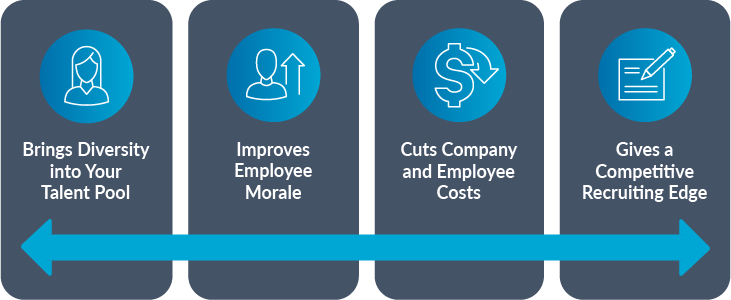
In an office without walls, employers can find the best candidates anywhere in the country or the world, expanding and enriching the range of talent they can access.
Trusting your employees with more flexibility has been shown to boost morale. Just take a look at these remote work statistics: Business Daily News reports that “remote employees work an additional 1.4 more days per month than in-office employees, which is nearly 17 additional workdays a year.”
An increase in remote work often coincides with a decrease in company expenses. Companies are realizing that they can slash several overhead expenses and lower costs for utilities, employee lunches and office supplies.
Ultimately, employers must weigh pros and cons and consider remote work trends to decide if offering this option is right for your organization. To make an informed decision, weigh the challenges as well as the benefits.
A company’s willingness to offer work-from-home and flexible work arrangements is crucial to attracting and retaining top talent. But recruiting a remote worker is different from the traditional process.
It’s important to keep in mind that hiring remote workers is becoming so commonplace that the benefit of working remotely is not enough to offset lower wages. Since workers are no longer willing to sacrifice pay in exchange for remote work benefits, employers need to adjust hiring practices accordingly. Employers must carefully navigate compensation complexities. Here are two compensation options to keep in mind when hiring a remote workforce:
Even strong proponents of remote work acknowledge that leading remote teams does come with its own host of challenges. However, when leaders can anticipate these issues, it’s easy to devise solutions that can alleviate, or at least mitigate, them. Let’s have a look.
In remote workforce management, a lack of communication can leave employees feeling like they are isolated and that their work isn’t valued. Some remote work employees experience isolation and a decline in mental health, which can lead to depression, anxiety and loneliness. Naturally, this is one of the most concerning challenges of managing remote employees.
Solution: Flip the script. The same technology that allows employees to work from home can also be used to engage them in remote team building or other activities that reduce isolation. As a leader in your organization, you should do all that you can to foster a culture of shared communication and comradery on your team so that your employees want to communicate with and involve each other in their work.
Technological tools can have a big impact on the challenges of managing remote employees. Carefully design how your team is using email, text, phone calls, video chats, online calendars, intranet sites and chat room software, like Slack or Microsoft Teams.
Holding employees’ attention amid the distractions of home and other people isn’t always easy. It’s not as if they have the same transparency around productivity that they might have in an office.
Solution: Encourage employees to adhere to a schedule that can accommodate both work and personal needs. Then show them how to create systems for their specific situations that will help to keep them focused and on task. Be absolutely sure you have set clear expectations.
Project management systems can help you make sure your team is doing what’s needed to accomplish tasks, even when they’re not sitting at their desks on site. Many tools are developed specifically to facilitate collaboration.
When it comes to managing a remote team, clarity is paramount. Here’s how to ensure you’ve established that:
Sometimes the blurring of lines can be difficult when work and home life meld. Many remote employees struggle to defend personal and family time with the always-on nature of remote work. Plus, long virtual calls and jam-packed schedules can cause video chat fatigue. For this reason, burnout is a challenge of managing remote employees.
Solution: The remedy for this problem comes down to creating good boundaries. Remind employees that they should pause throughout the day and take full lunch breaks at home, just as they would if they were physically in an office building. If you’re wondering how to manage remote employees, it may be helpful to examine the meetings your team is attending and how they are going.
To combat virtual fatigue, it’s best to streamline meetings by focusing on narrow topics while offering regular breaks. Instead of having a long meeting every month or quarter, consider shorter but more frequent virtual huddles.
Another challenge of managing remote employees is the ability to coordinate well and work in tandem. Team members working on their own may find it tough to realize their value to the team and they could have issues with collaborating with others.
Solution: Make sure that remote team building activities incorporate collaboration on specific work projects. Other tips include sharing documents that track work activities, notes the Society for Human Resource Management (SHRM). It’s encouraging when team members can see where they can help and add value to others and recognize how their efforts fit into larger goals.
Track progress toward achieving key milestones and other successes as a group. Incentivize your team to do the same with their peers and catch up with each other outside of the daily work topics.
The last thing you want is for your employees to feel like they are on an island. In remote workforce management, you must define ways to communicate with your remote staff regularly, keeping them apprised of deadlines, available resources, work-related challenges and the company’s expectations of them.
Managing in person affords employers the opportunity to personalize feedback and recognition. Without it, team members may become disillusioned or stagnate.
Solution: Incorporate a human touch into a remote method for recognizing employees. Try virtual celebrations or rewards for recognizing efforts, ideas and achievements. If you offer a hybrid environment, be sensitive about potential on-site favoritism. On-site favoritism happens when employees who are in the office have more opportunities than employees who aren’t, which can tank your team’s morale and motivation quickly.
Resist the urge to consistently choose communication with the closest point of contact and purposefully reach out to remote workers. While it may be natural to converse more with the person who is right in front of you than it may be with a remote employee who is several states away, it’s incredibly important to combat any favoritism.
To be sure this is not a problem for you, be sure to:
Without recognition for their efforts and hard work, virtual team members may also wonder whether you can fully see and value their contributions to the company. Try implementing some of these rituals:
When it comes to remote work, team members often miss out on the typical water cooler talk and relationship building that naturally comes with physically being around their coworkers. Without these connections, it can be easy for team members to feel like they aren’t personally connected with their team or their role.
Solution: Host remote games for team building. Having fun at work shouldn’t be a stretch. Set aside times for fun (even optional) engagement. These moments can mimic the typical office banter that would otherwise happen in a brick-and-mortar setting, giving team members a venue to enjoy themselves and their peers.
Try a few of these remote team building games and virtual icebreakers for remote teams to encourage employees to enjoy some lighthearted moments together and connect with one another in a social role:
Remember that happy employees are productive employees. And, yes, happiness does actually affect your bottom line.
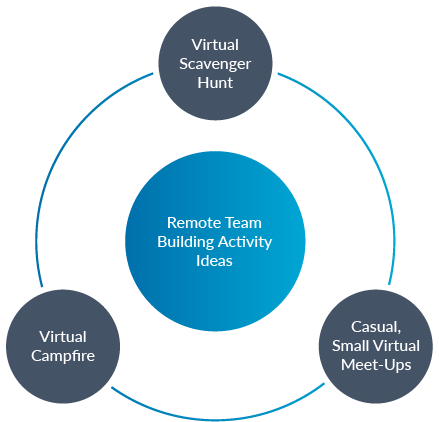
Savvy managers already know that relationships, connections and communication are essential for leading remote teams because they lead to higher morale, greater employee loyalty, increased productivity and improved employee retention.
Although overcoming remote work challenges is possible, the shift has managers wondering how to manage a remote team effectively. It starts with creating a plan.
Creating in-depth and supportive remote team best practices can help companies to develop a robust remote workplace model, manage their teams well and yield rewards for both your business and your employees.
By having an informed plan of how to manage a remote team, you can enjoy better employee retention and set expectations for productivity, communication, support and even create some fun within your organization.
Because employees lack face-to-face supervision, managers often worry their staff won’t work as hard or as efficiently. But managing remote employees isn’t all that much different than managing in person; it comes down to preparation.
Businesses should carefully consider what their policies will be in regard to remote work in particular.
Your old employee handbook may not cut it anymore. Applying a traditional personnel policy to remote and hybrid staff doesn’t always work because the environments and circumstances are so unique. A specific policy is a valuable asset in your managing remote employees toolkit.
You’ll want to mitigate the risks to your business, and without a remote work policy, you may be exposed to vulnerabilities. A remote workplace policy protects you and your employees and can prevent the troubles associated with miscommunication.
To begin writing your own guidelines, you can use this sample remote work policy template, which is easy to adjust to your company’s specifications. Let’s examine the key features of each component:
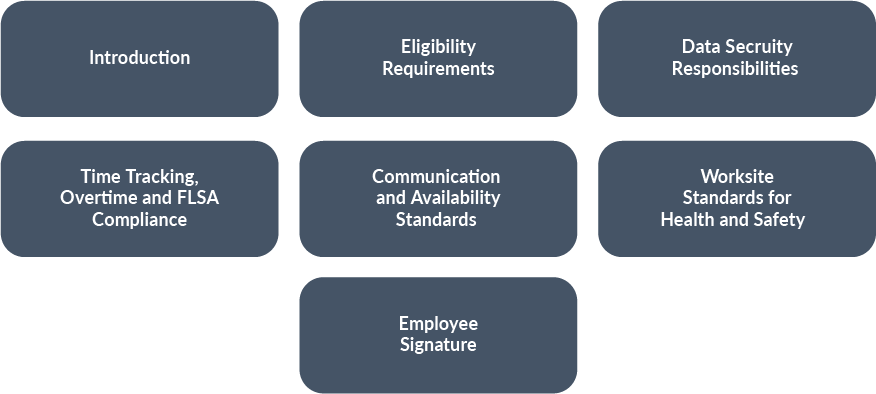
Be sure to convey how proud you are to offer them the opportunity to work remotely from an appropriate location. Remind all employees that being remote does not exempt them from policies and responsibilities similar to those for on-site workers.
First and foremost, you’ll want to develop standards that are fair for everyone and compliant with labor laws. Consider incorporating eligibility requirements to your remote work policy based on what duties are performed in a specific role and expectations from customers or vendors. If eligibility may be revoked in certain circumstances, it’s important to have that spelled out.
Security becomes a major factor in the viability of remote work, and often, additional training is needed. If you provide employees with devices (like laptops and drives), decide how each employee will avoid security risks, recognize them if they occur and understand how to take action.
Working with an IT team or an outsourced provider to set security expectations with your team is the best defense against breaches. Some base-level precautions include:
The Fair Labor Standards Act (FLSA) determines procedures for how employees can track hourly wages. Make sure that this is part of your policy and that hourly employees receive these guidelines and are trained to submit time appropriately. Outside of security concerns, time tracking is one of the most complex parts of a remote work policy.
Remote work depends on employee accessibility. As such, employees may need to be available for communication during agreed-upon work hours. If there are certain times when employees must respond to calls, texts, emails or other communications, it’s important to define them.
Liability doesn’t only pertain to physical office locations. Did you know that in some cases you could still face legal consequences if employees are injured when they are on the clock? Take the extra time to provide assurance that remote working conditions are safe and secure.
It may go without saying, but you’ll need to require employees to sign the remote work policy. This demonstrates that they have read and comprehended your terms.
While it may take some time to assemble, a robust remote work policy will protect your business. Plus, it ensures that everyone can focus on the tasks at hand, get clear on expectations and be set up for a successful remote work experience.
The demand for talent shows no signs of easing anytime soon, and finding qualified candidates continues to be highly competitive. So how do you pull ahead of the competition? While there’s no magic formula, following the steps in this guide can significantly improve your chances of finding top talent, especially if you stick to time-tested fundamental principles.
Apply these job recruitment fundamentals so that your strategy is up to par in today’s market.
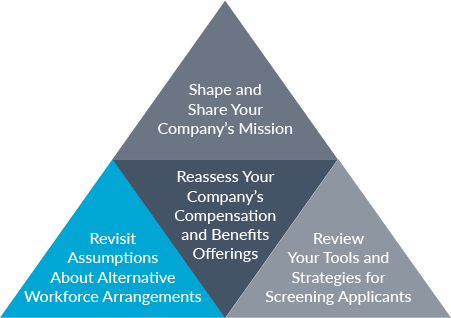
The modern job seeker wants to understand more than what their job description will be. They want to learn about your mission and vision. Be sure to convey the larger purpose your organization serves, including the culture, values, ethics, fundamental goals and agenda.
An inspired and engaging mission statement is your chance to get current employees, prospective applicants and pending candidates excited about what your company does.
It’s no longer correct to assume that remote work will result in lost productivity or organizational chaos. Studies of remote workers have revealed that they most often remain as productive, if not more so, when setting their own boundaries at home than when working in the office.
Furthermore, the multiple benefits of allowing work-from-home, work-from-anywhere or even hybrid workplace models have been enumerated extensively. Considering alternative working arrangements can enhance your job recruitment efforts.
In the new job market, employees review everything when making a decision, and compensation is at the top of the list. Organizations must be competitive—you can no longer afford to use your old playbook to determine a compensation and benefits package, so take a close look at the appropriate data for your area and industry to make sure you are up to date.
Consider assessing your current and prospective employees’ views as well and keep in mind that for many workers, “perks and pay are no longer enough.”
Screening applicants can be one of the most time-consuming parts of staffing. To do it well, you’ll need to define the job recruitment process and approach screening with purpose. Carefully designed assessments that change with the dynamic job recruitment market can help.
Some best practices include the following:
And don’t forget to ensure you’ve eliminated any unconscious bias in the screening process.
If your company isn’t already operating according to industry best practices, there’s no time like the present to reset job recruitment fundamentals.

Today’s talent acquisition climate has new and different challenges. Companies that can navigate these challenges stand to attract and retain the best employees, resulting in a significant competitive advantage. But how do you even begin to overhaul your recruiting practices when time and resources are already tight?
Recruitment professionals can multiply your efforts or manage the process entirely. At Warren Averett Staffing & Recruiting, our recruiting team is experienced in helping numerous companies upgrade job recruitment, staffing and remote work strategies.
Our experts can manage every stage of the process and lend valuable insights to hiring for specific industries. We help you assess the right strategy for your organization and provide top-notch recruiting to let you build, retain and strengthen your dream team
